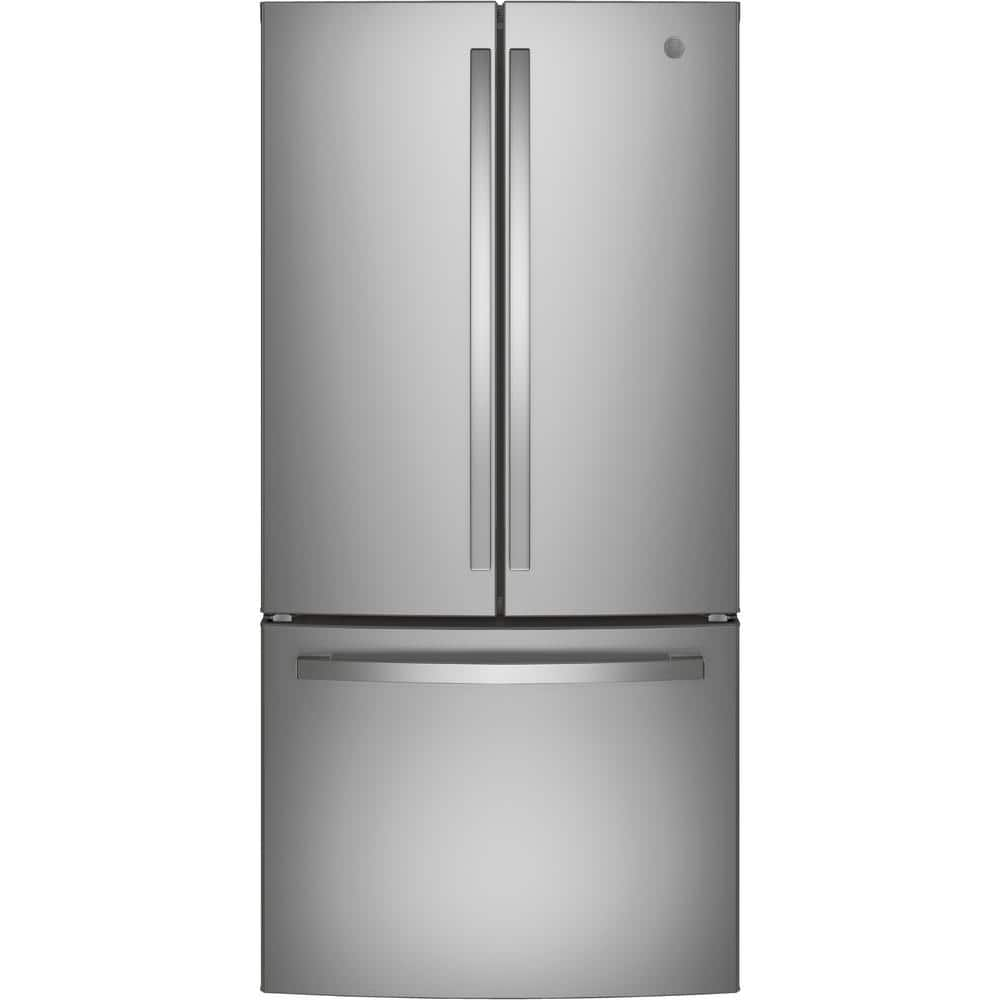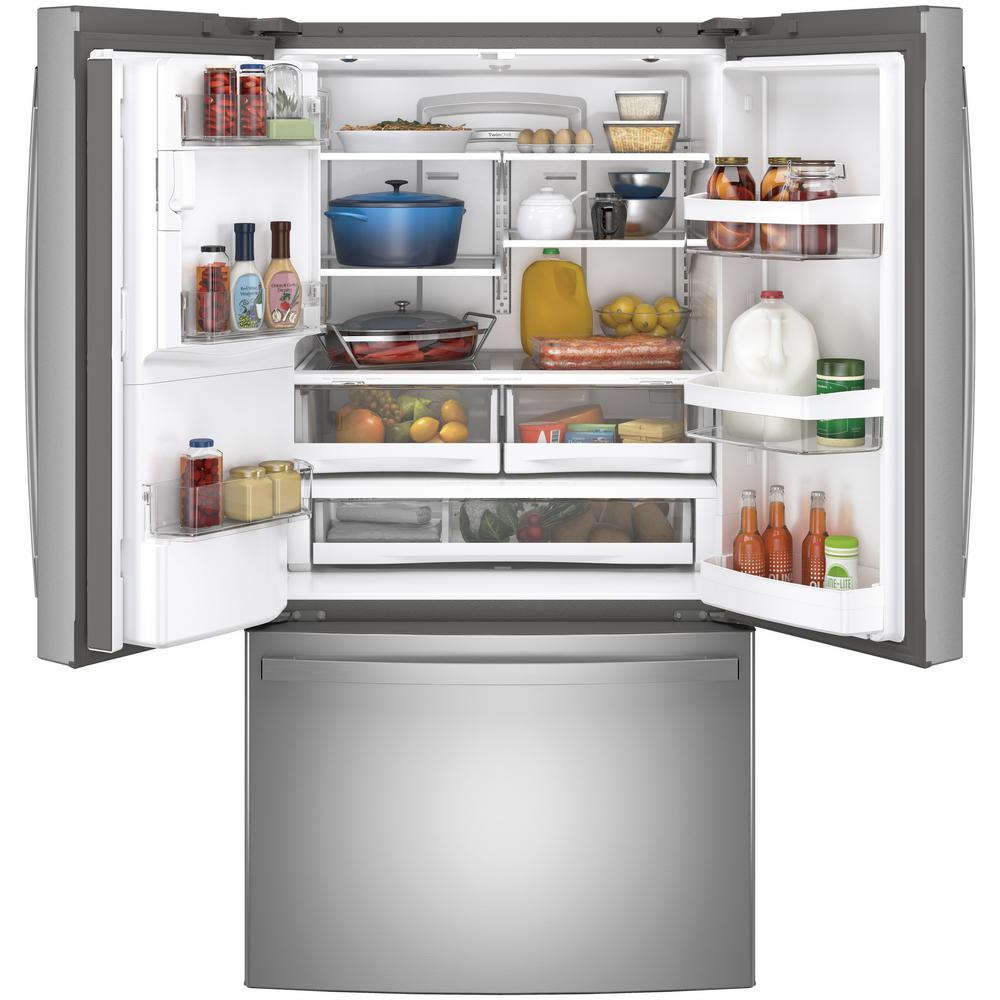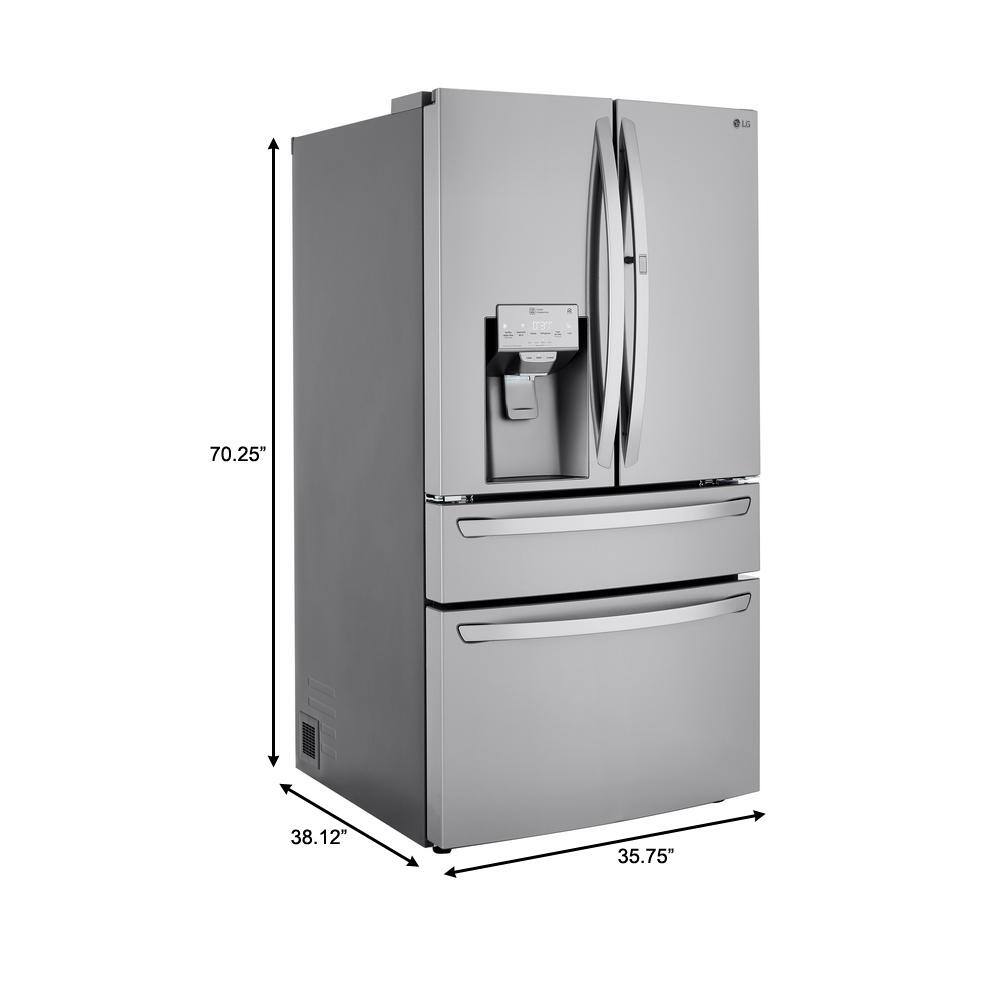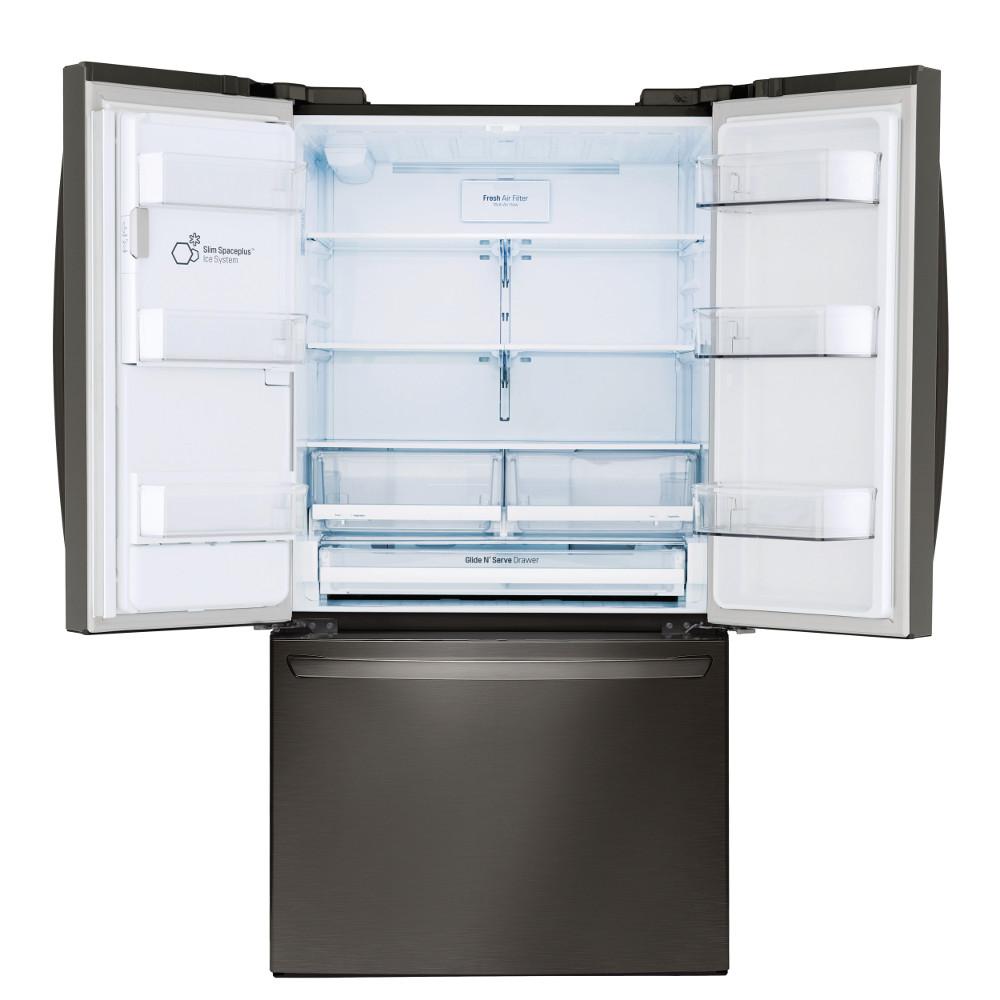GE 18.6 cu. ft. French Door Refrigerator in Stainless Steel, Counter Depth
Counter depth design creates a sleek built-in look. Internal water dispenser delivers water with one touch. LED lighting makes items easy to spot and retrieve.
GE appliances provide up-to-date technology and exceptional quality to simplify the way you live. With a timeless appearance, this family of appliances is ideal for your family. And, coming from one of the most trusted names in America, you know that this entire selection of appliances is as advanced as it is practical.
- Counter-depth design – Offers a built-in look by fitting nearly flush with surrounding cabinetry
- Internal water dispenser – Delivers filtered water with one touch
- Factory-installed icemaker with water filtration system – Refrigerator comes ready to automatically create filtered ice
- LED lighting – Find exactly what you’ve been looking for under crisp, clear lighting
- 2 humidity-controlled drawers and 1 full-width adjustable-temperature drawer –
- Turbo Cool setting – Drops interior temperature to maintain freshness after frequent openings
- Multi-level freezer baskets – Keep frozen foods organized and easy to find
- Upfront temperature controls with actual temperature display – Easy-to-reach controls display accurate temperatures
- Quick Space shelf – Quickly slides out of the way to make room for tall items
- Advanced water filtration uses XWF replacement filter
- Fits 33 in. openings
- Limited 1-year entire appliance warranty
- Designer style handle design
- Energy Star
Additional information
| Depth (Excluding Handles) | 29 |
|---|---|
| Depth (Including Handles) | 31 |
| Depth (Less Door) | 24.125 |
| Depth With Door Open 90 Degrees (In) | 42 |
| Height to Top of Door Hinge (in.) | 69.875 |
| Height to Top of Refrigerator (in.) | 68.625 |
| Product Depth x Height x Width (in.) | 31 x 69.88 x 32.75 |
| Refrigerator Width (In.) | 32.75 |
| Certifications and Listings | Certifications and Listings |
| Manufacturer Warranty | Limited 1-year entire appliance |
Eighteen or 18 may refer to:
- 18 (number), the natural number following 17 and preceding 19
- one of the years 18 BC, AD 18, 1918, 2018
6 (six) is the natural number following 5 and preceding 7. It is a composite number and the smallest perfect number.
A door is a hinged or otherwise movable barrier that allows ingress (entry) into and egress (exit) from an enclosure. The created opening in the wall is a doorway or portal. A door's essential and primary purpose is to provide security by controlling access to the doorway (portal). Conventionally, it is a panel that fits into the doorway of a building, room, or vehicle. Doors are generally made of a material suited to the door's task. They are commonly attached by hinges, but can move by other means, such as slides or counterbalancing.
The door may be able to move in various ways (at angles away from the doorway/portal, by sliding on a plane parallel to the frame, by folding in angles on a parallel plane, or by spinning along an axis at the center of the frame) to allow or prevent ingress or egress. In most cases, a door's interior matches its exterior side. But in other cases (e.g., a vehicle door) the two sides are radically different.
Many doors incorporate locking mechanisms to ensure that only some people can open them (such as with a key). Doors may have devices such as knockers or doorbells by which people outside announce their presence. (In some countries, such as Brazil, it is customary to clap from the sidewalk to announce one's presence.) Apart from providing access into and out of a space, doors may have the secondary functions of ensuring privacy by preventing unwanted attention from outsiders, of separating areas with different functions, of allowing light to pass into and out of a space, of controlling ventilation or air drafts so that interiors may be more effectively heated or cooled, of dampening noise, and of blocking the spread of fire.
Doors can have aesthetic, symbolic, ritualistic purposes. Receiving the key to a door can signify a change in status from outsider to insider. Doors and doorways frequently appear in literature and the arts with metaphorical or allegorical import as a portent of change.
French may refer to:
- Something of, from, or related to France
- French language, which originated in France
- French people, a nation and ethnic group
- French cuisine, cooking traditions and practices
A refrigerator, colloquially fridge, is a commercial and home appliance consisting of a thermally insulated compartment and a heat pump (mechanical, electronic or chemical) that transfers heat from its inside to its external environment so that its inside is cooled to a temperature below the room temperature. Refrigeration is an essential food storage technique around the world. The low temperature lowers the reproduction rate of bacteria, so the refrigerator reduces the rate of spoilage. A refrigerator maintains a temperature a few degrees above the freezing point of water. The optimal temperature range for perishable food storage is 3 to 5 °C (37 to 41 °F). A similar device that maintains a temperature below the freezing point of water is called a freezer. The refrigerator replaced the icebox, which had been a common household appliance for almost a century and a half. The United States Food and Drug Administration recommends that the refrigerator be kept at or below 4 °C (40 °F) and that the freezer be regulated at −18 °C (0 °F).
The first cooling systems for food involved ice. Artificial refrigeration began in the mid-1750s, and developed in the early 1800s. In 1834, the first working vapor-compression refrigeration, using the same technology seen in air conditioners, system was built. The first commercial ice-making machine was invented in 1854. In 1913, refrigerators for home use were invented. In 1923 Frigidaire introduced the first self-contained unit. The introduction of Freon in the 1920s expanded the refrigerator market during the 1930s. Home freezers as separate compartments (larger than necessary just for ice cubes) were introduced in 1940. Frozen foods, previously a luxury item, became commonplace.
Freezer units are used in households as well as in industry and commerce. Commercial refrigerator and freezer units were in use for almost 40 years prior to the common home models. The freezer-over-refrigerator style had been the basic style since the 1940s, until modern, side-by-side refrigerators broke the trend. A vapor compression cycle is used in most household refrigerators, refrigerator–freezers and freezers. Newer refrigerators may include automatic defrosting, chilled water, and ice from a dispenser in the door.
Domestic refrigerators and freezers for food storage are made in a range of sizes. Among the smallest are Peltier-type refrigerators designed to chill beverages. A large domestic refrigerator stands as tall as a person and may be about one metre (3 ft 3 in) wide with a capacity of 0.6 m3 (21 cu ft). Refrigerators and freezers may be free standing, or built into a kitchen. The refrigerator allows the modern household to keep food fresh for longer than before. Freezers allow people to buy perishable food in bulk and eat it at leisure, and make bulk purchases.
Stainless may refer to:
- Cleanliness, or the quality of being clean
- Stainless steel, a corrosion-resistant metal alloy
- Stainless Games, a British video game developer
- Stainless Broadcasting Company, a TV broadcaster based in Michigan, US
- Stainless Banner, the second national flag of the Confederate States of America
Steel is an alloy of iron and carbon with improved strength and fracture resistance compared to other forms of iron. Because of its high tensile strength and low cost, steel is one of the most commonly manufactured materials in the world. Steel is used in buildings, as concrete reinforcing rods, in bridges, infrastructure, tools, ships, trains, cars, bicycles, machines, electrical appliances, furniture, and weapons.
Iron is always the main element in steel, but many other elements may be present or added. Stainless steels, which are resistant to corrosion and oxidation, typically need an additional 11% chromium.
Iron is the base metal of steel. Depending on the temperature, it can take two crystalline forms (allotropic forms): body-centred cubic and face-centred cubic. The interaction of the allotropes of iron with the alloying elements, primarily carbon, gives steel and cast iron their range of unique properties. In pure iron, the crystal structure has relatively little resistance to the iron atoms slipping past one another, and so pure iron is quite ductile, or soft and easily formed. In steel, small amounts of carbon, other elements, and inclusions within the iron act as hardening agents that prevent the movement of dislocations.
The carbon in typical steel alloys may contribute up to 2.14% of its weight. Varying the amount of carbon and many other alloying elements, as well as controlling their chemical and physical makeup in the final steel (either as solute elements, or as precipitated phases), impedes the movement of the dislocations that make pure iron ductile, and thus controls and enhances its qualities. These qualities include the hardness, quenching behaviour, need for annealing, tempering behaviour, yield strength, and tensile strength of the resulting steel. The increase in steel's strength compared to pure iron is possible only by reducing iron's ductility.
Steel was produced in bloomery furnaces for thousands of years, but its large-scale, industrial use began only after more efficient production methods were devised in the 17th century, with the introduction of the blast furnace and production of crucible steel. This was followed by the Bessemer process in England in the mid-19th century, and then by the open-hearth furnace. With the invention of the Bessemer process, a new era of mass-produced steel began. Mild steel replaced wrought iron. The German states were the major steel producers in Europe in the 19th century. American steel production was centered in Pittsburgh, Bethlehem, Pennsylvania, and Cleveland until the late 20th century.
Further refinements in the process, such as basic oxygen steelmaking (BOS), largely replaced earlier methods by further lowering the cost of production and increasing the quality of the final product. Today more than 1.6 billion tons of steel is produced annually. Modern steel is generally identified by various grades defined by assorted standards organizations. The modern steel industry is one of the largest manufacturing industries in the world, but also one of the most energy and greenhouse gas emission intense industries, contributing 8% of global emissions. However, steel is also very reusable: it is one of the world's most-recycled materials, with a recycling rate of over 60% globally.






by Loriann
Surprisingly Pleased! We had been looking for about 6 months to replace a 28 yr old fridge. We have a galley kitchen and needed a smaller counter depth frig. I was insistent on two things….double doors and a bottom freezer. He was insistent on two things…correct size and no ice fancy water/ ice machine. He’s a Heat/AC service guy and works on ice machines also. Nothing but horror stories on that subject, leaks, mold etc. =Gross! We both agreed on Slate because we don’t like fingerprints and price, less than $2000. Home Depot was exceptional from Step 1 of our process. We were concerned it would be 6+ months between ordering and receiving one because of coronavirus. Shout out to Jackie in the Appliance dept. helped us through the whole order process in about 20 minutes. She ordered one form a warehouse to be shipped to our closet location ( Hermiston, Or) for pickup and two days later she personally called and said it was in. We picked it up the very next Saturday and it was pouring rain. After inspecting for dents…they wrapped it tight with plastic and helped load it to go over a steep mountain home. (2 hour drive) Our son came to help in put in in and he described opening it up as Uhwahhhhh! like opening the doors to heaven when it lights up. My grandkids love that it beeps when your have the door open too long. My fear was the comments in the reviews about the loudness of it running and the small freezer storage. There is definitely more room inside the refrigerator than my old one. YES, the freezer is a bit small but I have an extra small freezer in the garage to help with that and NO, there is no loud noise. This is whisper quiet to me. The only reason I gave 4 star review is because of the opening and closing of the doors are little bit loud and drawers are all plasticky and probably will not last 20 yrs like the old ones did but Hey~ we know how times have certainly changed in sturdiness of new products. We’re happy with our purchase and thankful to Home Depot for the help 😉
by Renee
Works great. Love the turbo cool feature.
by Alliance
Great change from the dual power RV frig. Pros: More room in the cooling area, ice maker and fresh cooled water. Cons: freezer is very small, dual power frig actually had a bigger freezer.
by Sherose
This is a smallie refrigerator than we are used to but we absolutely love it. It’s laid out very well and there is lots of Room on the doors for storage. So far so good!
by Smith
We finally got rid of our side by side GE refrigerator and upgraded to this one with a freezer drawer. What a difference! I love it so far.
by Candy
I love everything about this frig. I’m recently widowed and to kept busy I’m remodeling. First thing I researched was a frig. I love that it’s countertop depth, water dispenser in the frig so the outside of the frig looks classy and there is so much room. I just love it.
by Swegen
So far, all is good with the new frig! Our first bottom drawer freezer and its works for us. Selected the internal water dispenser feature vs through door. We like this feature as no maintenance is required vs the through door feature. The French doors are another feature we like that allows better access across the frig. Our last GE frig lasted 23 years, we trust this one will too.
by Jim
Love my new French door GE refrigerator with freezer/ice maker on bottom! The French door set up is fabulous as you can store large items (large pizza box, sheet cakes, etc.) Can’t go wrong with GE brand…great American company around for years and products last forever…also purchased GE slide-in gas range! Love it as well!
by Fridge
This was a challenge to say the least. I live in a 2013 5th wheel trailer and it had an absorption fridge, that was not good. I would load it with groceries and it would take hours to return to temp. Removing it and doing the carpentry to fit in my new GE fridge was quite a bit of work, but it has paid off greatly. I love my new fridge:-)